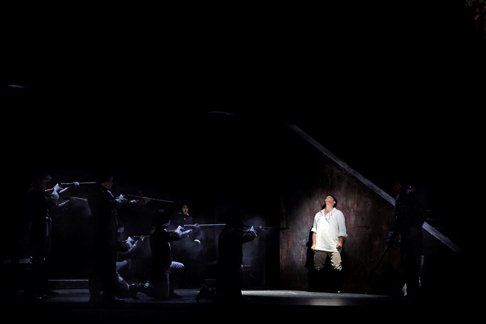06 Feb 2013
Tosca by Arizona Opera
The libretto by Luigi Illica and Giuseppe Giacosa for Giacomo Puccini’s opera Tosca is based on Victorien Sardou’s French play, La Tosca.

The libretto by Luigi Illica and Giuseppe Giacosa for Giacomo Puccini’s opera Tosca is based on Victorien Sardou’s French play, La Tosca.
Since they are sung, a mere one-third of the words found in the play have to tell the opera’s story. Thus, the opera needs to have fewer characters than the play and only the most important scenes can be shown. For example in the opera, the escaped prisoner, Angelotti, and the painter, Cavaradossi, already know each other. In the play, they meet for the first time onstage, so they spend time on stage explaining their histories and backgrounds to each other. The opera eliminates the roles of Tosca’s maid and Cavaradossi’s two servants.
 Jill Gardner as Tosca and Gordon Hawkins as Scarpia
Jill Gardner as Tosca and Gordon Hawkins as Scarpia
In the opera, both Cavaradossi’s torture and Scarpia’s murder take place at the Farnese Palace. In the play, Cavaradossi is interrogated and tortured at his country house, where he was captured, and Tosca stabs Scarpia at his apartment in the Castel Sant’Angelo. Only in the opera does Cavaradossi have a final soliloquy: ‘E lucevan le stelle’ (The Stars Were Shining Brightly). In the play, Cavaradossi is killed off stage, not in front of the audience as he is in the opera. At the very end of the play, Spoletta tells Tosca that he and his men will send her to join her lover. She cries “J’y vais, canailles!” (“I am going there, swine!”). In the opera, her final words are more dignified: “O Scarpia, avanti a Dio!” (“O Scarpia, before God!”).
On the evening of January 26, 2013, Arizona Opera presented an interesting traditional production of Tosca with an excellent cast. The set by Donald Oenslager was constructed in the 1950s for the New York City Opera. In the first scene, in the Church of Sant’Andrea della Valle, the painted set looks as if the nave is miles deep. That painted set will be archived after these performances and it certainly deserves to be kept as an example of stage perspective, now a rarely seen art. The costumes by A.T. Jones and Sons set the era perfectly. Director Bernard Uzan told the story in energetic verismo style. This was opera as contact sport and it was wonderful to see.
Jill Gardner’s Tosca was a thinking diva who used her feminine wiles to get her way. She sang with dramatic tones that belied her slim stature. Adam Diegel was an intense Cavaradossi who started off slowly but sang his Vittoria with exciting sounds. His final ‘E lucevan le stelle’ was an unwavering expanse of lyrical sound. Gordon Hawkins was a rather thuggish Scarpia who bullied not only his victims but also his underlings. His sole moment of real dignity was the ‘Te Deum.’
 Execution of Cavaradossi (Adam Diegel)
Execution of Cavaradossi (Adam Diegel)
Peter Strummer was a most amusing Sacristan who thoroughly enjoyed irritating Cavaradossi whom he thought a non-believer. There was a good bit of horseplay in the middle of Act I, but musically, no one missed a beat. In two of the smaller parts, Craig Colclough declaimed Angelotti’s lines with vigor and great dignity in Act I and showed his comic side as the lazy Jailer in the last act. Members of AZ Opera’s young artist program showed their promising abilities. David Margulis was a sadistic Spoletta and Thomas Cannon a strong and striking Sciarrone.
Chorus Master Henri Venanzi has made the Arizona Opera Chorus into a first rate ensemble and they sang their scenes with great gusto. Principal Conductor Joel Revzen gave a powerful rendition of the verismo score that added greatly to the dramatic situations seen on stage. As always, he was most considerate of his singers and at the same his rendition had well thought out tempi and a great deal of translucence. It was a dark, rainy day outside but in Phoenix Symphony Hall there was the sunshine of Roman drama.
Maria Nockin
Cast and Production
Tosca: Jill Gardner; Cavaradossi: Adam Diegel; Scarpia: Gordon Hawkins; Sacristan: Peter Strummer; Angelotti/Jailer: Craig Colclough; Spoletta: David Margulis; Sciarrone: Thomas Cannon; Shepherd Boy: Bevin Hill. Arizona Opera Chorus and Phoenix Boys Choir, Chorus Master: Henri Venanzi; Arizona Opera Orchestra, Conductor: Joel Revzen; Director: Bernard Uzan; Sets: Donald Oenslager; Costumes: AT Jones and Sons; Lighting Design: Michael Baumgarten. Arizona Opera January 26, 2013.